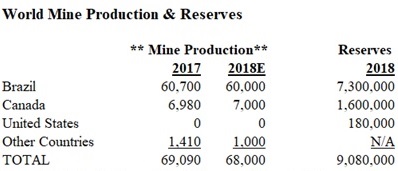eResearch | Niobium has been declared a “strategic metal” by the U.S. government, with stockpiling recommended for niobium along with other strategic metals.
Niobium is quite rare. It is estimated to be the 34th most common element in the Earth’s crust. The free element is not found in nature. However, niobium occurs in combination with other elements in minerals.
Uses for Niobium
Niobium is primarily used by the steel industry to increase strength, toughness, corrosion resistance, as well as reduce the weight of alloy products. Niobium is used mostly in alloys, the largest part in special steel such as that used in gas pipelines. Although these alloys contain a maximum of 0.1%, the small percentage of niobium enhances the strength of the steel.
Niobium is used by the aerospace industry in nickel-, cobalt-, and iron-based super-alloys. The temperature stability of niobium-containing super-alloys is important for its use in jet and rocket engines. Niobium-geranium, niobium-tin, and niobium-titanium alloys are used in super-conducting magnets for magnetic resonance imaging instruments and in particle accelerators.
Other promising uses for niobium at an early stage of development and discovery include significantly increasing the recharging speed of lithium-ion batteries, and in developing the field of quantum computing. Additional applications for niobium include electro-ceramics, medicine, jewellery, and numismatics.
Niobium Research
Niobium, due to its variety of properties, is used in several areas of research, including creating magnets. One of the strongest super-conducting magnets in the world uses niobium alloy wires, such as niobium-tin and niobium-titanium. One such use for a super-conducting magnet is in magnetic resonance imaging (MRI) or spectroscopy (MRS).
World Resources
World resources of niobium are more than adequate to supply projected needs. Most of the world’s identified resources of niobium occur as pyrochlore in deposits of carbonatite (igneous rocks that contain more than 50% by volume of carbonate minerals).
There are only three known mines in the world that are currently mining niobium as the primary ore. Two of these are in Brazil, which produces about 90% of world output, and the third is an underground mine in the Province of Québec. These mines were founded in the 1950s, and they are still the major producers of niobium mineral concentrates.
The following table shows global production and reserves.

eResearch Industry Report
An eight-page report on the niobium industry can be accessed here: Niobium Industry_112519
//



